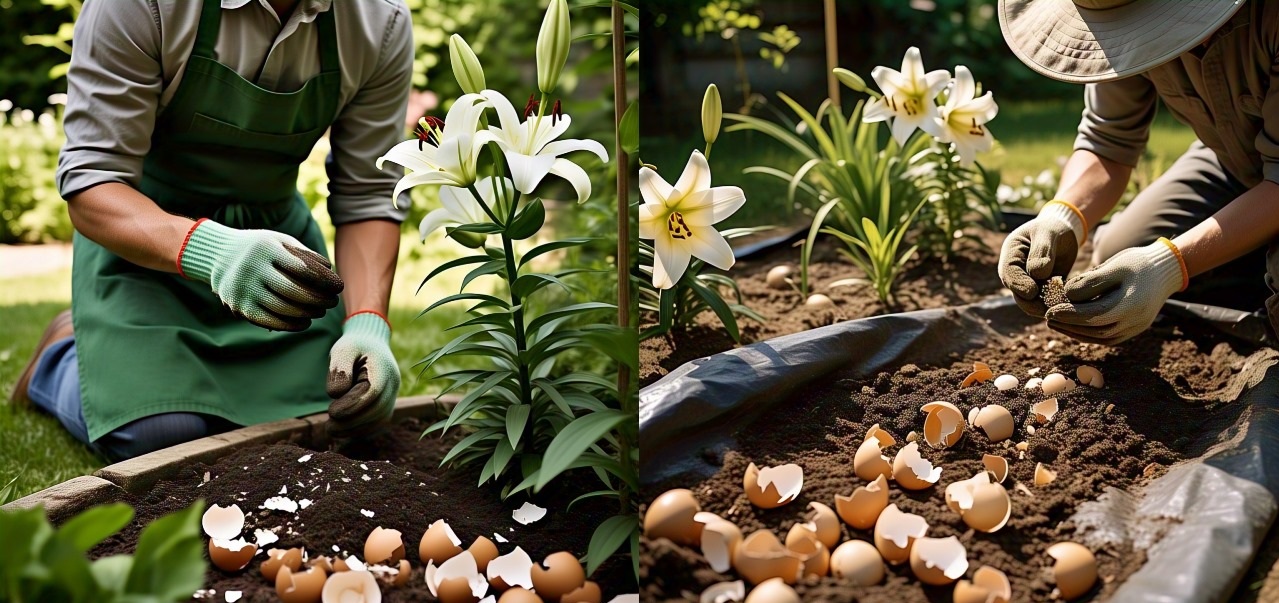ADVERTISEMENT
# Grow Gorgeous Lilies: Using Eggshells as a Natural Fertilizer
**Meta Description:** Discover the secret to vibrant lilies! Learn how to use eggshells as a natural fertilizer to boost growth, improve soil health, and achieve stunning blooms. Get our step-by-step guide now!
Imagine a garden bursting with the elegant beauty and intoxicating fragrance of lilies. To achieve this breathtaking display, you need healthy, nutrient-rich soil. Forget expensive chemical fertilizers! This guide reveals a simple, sustainable, and surprisingly effective method: using eggshells as a natural fertilizer for your lily plants. This eco-friendly approach provides essential nutrients, improving soil structure and promoting vibrant blooms. Let’s delve into the details of growing stronger, healthier lilies using this readily available resource.
## Ingredients List

* **10-12 Clean, Dry Eggshells:** From any type of egg—chicken, duck, etc.! Make sure they’re thoroughly rinsed and free of egg residue.
* **Water (Optional):** For creating an eggshell tea.
* **Used Coffee Grounds (Optional):** Adds nitrogen to your eggshell mix, creating a more balanced fertilizer. Let them cool completely before mixing.
* **Banana Peels (Optional):** Boost potassium and phosphorus levels. Chop them finely for faster decomposition.
* **Compost (Optional):** Improves overall soil health and provides additional nutrients.
## Timing
* **Prep time:** 15-20 minutes (depending on your method of crushing the eggshells)
* **Application time:** 5-10 minutes
* **Total time:** 20-30 minutes
This method is incredibly time-efficient compared to purchasing and applying commercial fertilizers. You can prep your eggshell fertilizer over a weekend and enjoy the benefits for weeks to come!
## Step-by-Step Instructions
### Step 1: Rinse and Dry Your Eggshells
Thoroughly rinse the eggshells under cold water to remove any remaining egg white or yolk. Air drying is ideal, but you can speed things up by baking them in a preheated oven at 200°F (90°C) for about 10 minutes. Ensure they’re completely dry before proceeding to prevent mold growth.
### Step 2: Crush Those Shells!
Once dry, crush the eggshells into a fine powder. A blender, food processor, or even a sturdy mortar and pestle works well. Finer powder allows for faster nutrient absorption by the soil. Avoid leaving large chunks as these will take much longer to break down.
### Step 3: Incorporate into Your Soil
For new lily plants, mix 1-2 tablespoons of crushed eggshell powder directly into the soil at the planting site. For established lilies, gently sprinkle the powder around the base of the plant and lightly work it into the top layer of soil.
### Step 4: Water Wisely
After adding the eggshell powder, water thoroughly. This ensures the calcium and other minerals dissolve and become readily available to the lily roots.
### Step 5: (Optional) Make Eggshell Tea
For a liquid fertilizer, boil 6-8 crushed eggshells in a liter of water for about 10 minutes. Let the mixture steep overnight, then strain and water your lilies with it once a week.
## Nutritional Information (Per 1 Tablespoon of Eggshell Powder)
| Nutrient | Approximate Amount |
|—————–|——————–|
| Calcium | 100-150mg |
| Magnesium | 5-10mg |
| Phosphorus | 2-5mg |
| Potassium | 1-3mg |
*Note: These values are approximate and can vary depending on the eggshell size and preparation method.* Focus on the overall benefit of adding these essential minerals for soil health.
## Healthier Alternatives & Adaptations
If you’re aiming for a completely organic approach, combine the eggshells with composted organic materials. This method avoids the need for any chemical additions whatsoever. For an added boost of nitrogen, add used coffee grounds to the mix.
## Serving Suggestions (for the soil!)
Evenly distribute the eggshell powder or liquid fertilizer around the base of your lily plants. Avoid direct contact with the stems and leaves to prevent potential issues.
## Common Mistakes to Avoid
1. **Overusing Eggshells:** Too much calcium can alter the soil’s pH, so start with a small amount and gradually increase as needed.
2. **Not Crushing Finely:** Large pieces decompose slowly, diminishing the fertilizer’s effectiveness.
3. **Using Dirty Eggshells:** Unclean shells can attract pests.
4. **Mixing with Chemical Fertilizers:** Eggshells are best used in combination with other organic matter or independently.
5. **Ignoring Soil Tests:** Prior to using eggshells, it helps to test the soil’s pH and adjust as needed.
## Storing Tips
Store crushed eggshells in an airtight container in a cool, dry place. This keeps them dry and prevents clumping. They can be stored indefinitely, making this a readily available resource all season long.
## FAQs
**Q1: Can I use eggshells from all types of eggs?** A1: Yes! Chicken, duck, quail—any egg will work.
**Q2: How often should I fertilize my lilies with eggshells?** A2: Once or twice during the growing season is generally sufficient. Observe your plants; if they look healthy and are blooming well, you likely don’t need any further fertilization.
**Q3: Will eggshells attract pests?** A3: Only if they are not cleaned properly. Thoroughly rinse them before drying to prevent pest issues.
**Q4: Are eggshells safe for pets?** A4: Eggshells themselves are not poisonous, but large pieces could be a choking hazard for smaller pets. Fine powders however are not likely to cause issue if ingested in small amounts.
**Q5: Can I use eggshells for other plants besides lilies?** A5: Absolutely! Many plants benefit from the calcium and other minerals in eggshells. Roses, tomatoes, and leafy greens all tolerate them well!
## Conclusion
Using eggshells as a natural fertilizer is a cost-effective and environmentally friendly way to nurture your lily plants. By following these simple steps, you can transform kitchen waste into a valuable gardening resource, resulting in healthier, stronger plants and more vibrant blooms. It’s a small change with big rewards – so give it a try and share your results with us in the comments below! Next, check out our guide on Read our How to Prevent Lily Diseases next! and Read our How to Choose the Best Lilies for Your Garden next! to maximise your lily-growing journey!
